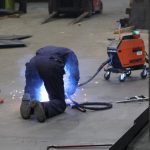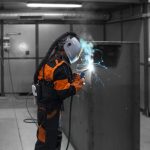Protecting people and the environment from hazardous substances
So that people and the environment are protected from hazardous substances, regulations are needed on how to deal with such substances. The Committee for Hazardous Substances (AGS) develops these regulations – and has done so for 50 years. What hardly anyone knows: The 20 volunteer members – who work in the chemical or pharmaceutical industry, in ministries or research institutions, for example – influence millions of people through their work. They advise the German Federal Ministry of Labour and Social Affairs, which translates the Committee’s recommendations into ordinances, technical regulations and draft legislation at national and international level. Welders also benefit from the Committee’s recommendations in terms of protective welding equipment.
 The early 1970s, when the Committee’s forerunner – the Committee for Working Materials – was established, saw the development of many new technologies. These led to profound changes in the world of work and to a crisis in the economy. Recent developments in genetic engineering and biotechnology, robotics and sensor technology, telecommunications and microelectronics as well as computer-aided design and manufacturing have enabled savings in labour, materials and energy. But they also changed production processes and workplaces in ways that required higher safety standards.
The early 1970s, when the Committee’s forerunner – the Committee for Working Materials – was established, saw the development of many new technologies. These led to profound changes in the world of work and to a crisis in the economy. Recent developments in genetic engineering and biotechnology, robotics and sensor technology, telecommunications and microelectronics as well as computer-aided design and manufacturing have enabled savings in labour, materials and energy. But they also changed production processes and workplaces in ways that required higher safety standards.
Regulations for handling hazardous substances
Consequently, the task of the members of this newly formed committee was to identify sources of danger at the workplace and to develop recommendations for action to make working safer. In 1996, the adoption of the Occupational Health and Safety Act changed the requirements for the experts. One central element of the legislation was actually the occupational risk assessment. This assessment is used to analyse all hazards in the workplace. These can be substances that are used for processing or also machines that have to be operated.
Identifying substances hazardous to health
Even 50 years after its foundation, the members are looking for ways to protect people from illness and injury in the workplace. Their recommendations are incorporated into directives and legislation. This requires the identification of hazardous and health-endangering substances, for example, and the description of their handling. For this purpose, the committee members write hazard assessments, risk concepts, safety data sheets and they set limit values for workplaces. The substances from which workers must be protected include benzene, quartz dust, asbestos, artificial mineral fibres or welding fumes. In order to also incorporate the industry-specific conditions for handling hazardous substances into the regulations, the members of the AGS are supported in their work by consultants who have this industry-specific knowledge. For the welding fume sector, for example, these are the experts of the Institute for Occupational Safety (IFA), the Institute for Prevention and Occupational Medicine (IPA) of the Employer’s Liability Insurance Association for Wood and Metal (BGHM) or the German Welding Society (DVS).
An environment free from toxins
One challenge in the coming years will be the implementation of the EU chemicals strategy. In the face of climate change, the EU states have agreed on the ‘Green Deal’. The initiative aims to better protect people and the environment from harmful influences. For this reason, scientists, experts from various industries and politicians are now looking for alternatives to substances of particular concern. The aim is to create a ‘non-toxic environment’, an environment that is free from toxins. But, in reality, this is hardly possible. This is because metals that produce carcinogenic substances during processing are still needed in the production of storage media. The next few years will therefore be dominated by questions on how to deal with these substances.





